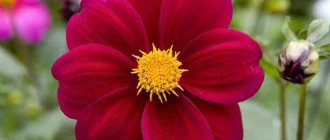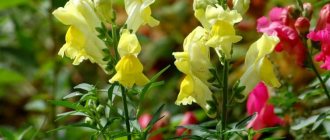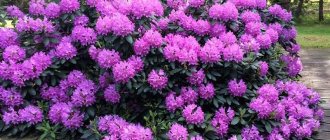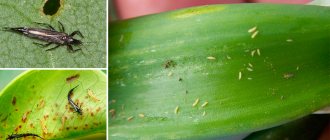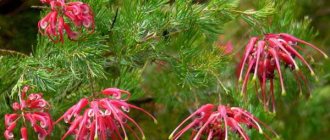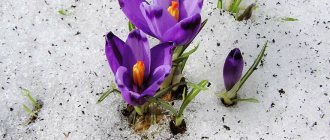Rhododendron has a wide variety of varieties that can be grown in any region, despite the low winter hardiness of the plant. At the same time, for propagation it is not necessary to purchase ready-made seedlings from a special nursery - it is enough to know how to propagate rhododendron in order to expand your collection of these plants on the site. Let us immediately note that rhododendron allows you to organize propagation by cuttings in water, layering, grafting and dividing the bush. All methods will be discussed in detail below.
Step-by-step instructions for propagation by cuttings
Cuttings of rhododendrons is one of the most productive ways of propagating them. The process is quite complex and time-consuming, but the result will please the owner.
Rhododendron in the nursery
It is worth cutting off branches for subsequent propagation of trees after they finish flowering. Thus, it is necessary to begin harvesting deciduous species at the end of May, but if we are talking about evergreen species, then cuttings of rhododendrons take place in the summer, before the 10th of July.
Additional Information! Deciduous and evergreen species take root better than others. All types of rhododendrons have one thing in common - long rooting.
Green shoots begin to become covered with a thin crust at the indicated time, and by mid-July lignification reaches the middle of the shoots.
It is necessary to cut 5-8 cm from the shoots so that there are at least 4 leaves on this segment with a couple of nodes between them. The shoots prepared in this way should be placed in a container with a previously filled nutrient substrate, which is sand and peat in equal proportions. It is recommended to make the soil layer at least 7 cm with the same level of drainage underneath. In this case, the drainage should be separated from the soil by 2 cm of coarse sand.
In the fall, the cuttings will take root, so they should be transplanted into boxes filled with an acidic substrate, which is prepared according to one of the recipes:
- 2 parts acid peat to 1 part pine needles;
- 1 part sand and pine needles to 2 parts acidic peat and leaf soil.
The cuttings are planted at a distance of 10 cm between them. The tops of the seedlings need to be pinched. Containers with plants need to be moved to a colder room, which is a basement or cellar. The temperature there should always be around 5 degrees Celsius. A deviation of 2-3 degrees is available.
Propagation of rhododendron by stem cuttings
With the onset of winter, the seedlings need to be moved to a bright place, with an air temperature of about 10 degrees Celsius. They will not be comfortable at room temperature, so care must be taken to create conditions favorable for growth.
In the spring it is worth planting plants in the ground: you can dig them both in containers and directly into the ground. The soil should have the same composition as it was during rooting. It is necessary to choose a good place so that the rays of the midday sun do not fall on the plant. After this, you should regularly water and spray the plant.
Important! The seedling will be ready for transplanting to a permanent place no earlier than after 2 years. For the winter, the plant should be covered with spruce branches or mulch. Care should be carried out as standard. Propagation by stem cuttings is most preferable for species such as azalea and wild rosemary.
Wintering
Mulch for covering plants for the winter
Since most hybrid species of rhododendron come from southern varieties, in the Middle Zone and especially in Siberia, they need shelter for the winter.
For proper shelter, preparations should begin in the fall.
For successful wintering, the soil under the bush must be moist, so if autumn is dry, the plant must be watered regularly.
The second stage of preparation is mulching the tree trunk circle. You can use spruce litter, peat or spruce sawdust as mulch.
If the bush is large enough, arches are installed above it in advance and subsequently covered with several layers of lutrasil. A small bush can be covered with a cardboard box or a hut made of spruce branches can be built.
This applies only to varietal rhododendrons. Most species forms overwinter without shelter.
How to propagate rhododendron from leaf cuttings
How to propagate hydrangea by cuttings in spring
The period for lignification of cuttings can be easily missed. If such a situation occurs, do not be upset, since the plant can be propagated in other ways. How to cut rhododendron with leaves? To do this, before the end of July, you need to cut off a leaf from a branch that has a couple of centimeters of bark and a bud.
Rhododendron blossom
The cut should be treated with a preparation that stimulates root growth. The substrate is prepared in the same way as for propagation by cuttings. It is necessary to deepen the cutting with a bud into the ground at a distance of 2 cm. With this method of propagating rhododendron, rooting occurs within 4 months. Initial signs can be observed during the first two months.
Important! If flowers begin to grow in the spring, they should be trimmed. The remaining manipulations for caring for the plant must be performed the same as when propagating by stems. As a result, you can get a beautiful rhododendron, the reproduction of which takes a long time.
Which method is better to choose?
When choosing a method of growing a crop, you need to take into account, first of all, the variety. Although it is also important that the grower has experience and time to care for rhododendrons.
See also
Planting and caring for miscanthus in open ground, types and varietiesRead
The seed propagation method is not suitable for growing varietal crops, since there is a possibility that the varietal characteristics will not be preserved. It is most practical and convenient to grow rhododendrons in a spacious area using layering. This method is most often used when growing deciduous varieties. It is preferable to propagate alpine varieties with creeping stems by dividing the bush. This propagation technique is also suitable for growing Rhododendron canada, which produces many rhizomes.
When using the cutting method, you need to keep in mind that deciduous varieties take root within 1-1.5 months, and evergreen varieties will take from 4 to 5 months.
Reproduction of rhododendrons by layering
How to propagate climbing roses by cuttings and layering
The layering method is different for other shrubs, so you need to know exactly how rhododendron reproduces using this method. Rooting other plants with layering is simple: you just need to bend and secure the branch. For this plant, the method becomes more complicated. Reproduction occurs in the spring.
In rhododendron, you need to select the outermost shoots to make layering easier. It is worth choosing the branches closest to the ground. You should not use several branches at once; it is recommended to make up to 5 layers at a time on the bush.
Reproduction of rhododendron by layering
At the point where the branch will touch the ground, you need to make a cut along the branch. You can avoid closing the incision by inserting a match into it. This is not necessary, but this technique allows you to speed up the growth of the plant. In the ground itself you need to dig a small hole 15 cm in diameter and depth.
Having bent the branch to the ground, it must be secured with a bracket or pin. From above you need to dig the shoot with an acidic substrate made according to the same recipe as for cuttings. The top of the shoot should be directed upward; to do this, it should be secured with a peg. In order for rooting to occur faster and better, it is necessary to organize regular watering so that the soil is consistently moist.
Additional Information! Roots may appear by autumn, which means they are ready for replanting. But if the region is famous for its harsh winters, then it is worth holding off on planting the bush, since the plant will not be able to adapt in time and will die. It is recommended to cover the cuttings with leaves and spruce branches until next spring.
Soil composition
It is believed that rhododendron prefers to grow in acidic and loose soil, so when planting seeds, it is necessary to create such conditions as much as possible so that no difficulties arise at this stage. There are several recipes that help create the best soil option.
- For an optimal substrate, it is necessary to combine one part of pine compost and two parts of peat and river sand. These are the proportions that will make an excellent mixture for rhododendrons.
- You can also avoid adding compost and use exclusively acidic peat, or as it is called high peat, as well as sand. In this combination, the amount of peat should be increased three times.
- The easiest way is to purchase a ready-made mixture for rhododendrons, or, as an option, a mixture for azaleas is suitable.
It doesn’t matter what mixture you choose, the main thing to remember is that it is recommended to pre-calcinate the sand, but steam peat and compost. If you strictly follow the recipe and adhere to the recommendations, then success is guaranteed.
Propagation of rhododendrons by seeds
How to propagate lavender from a bush using cuttings
Seeds are not the most effective and easiest way to quickly propagate rhododendron from cuttings. Such a plant will begin to bloom in 5-10 years. Sowing should be done at the end of February or in the spring. Seeds are sown in containers that have drainage holes. The substrate for sowing is the same as in other methods of propagating rhododendron at home. The soil also needs to be pre-disinfected.
Rhododendron seeds
After completing the preparatory stages, sowing should begin:
- You need to pour the prepared substrate into a container, carefully level the ground, but do not compact it.
- Scatter the seeds on the surface infrequently so that subsequently thinning and picking of seedlings is done less often.
- Depending on the size of the container, it is necessary to water either through a tray or using a watering can with a fine mesh. Excess moisture should drain freely. Water the seeds with acidified or soft water.
- The container should be covered with film or glass.
It is worth placing the containers in a place with average room temperature. Shoots should appear in about a month; high air and substrate humidity must be maintained. It is necessary to remove the glass or film from young seedlings and move them to a colder room with a temperature of about 10 degrees. Plant picking is done in June.
Important! In the summer, it is recommended to place the plants in the garden or greenhouse at the dacha, but with the onset of cold weather, it is necessary to transfer containers with rhododendrons to a room with a temperature of up to 18 degrees. Plants need to be illuminated throughout the winter, since the duration of daylight for them is 17 hours.
You can transfer seedlings into the soil only in the third year after planting. This is done in the spring. But it is worth planting rhododendrons in a permanent place no earlier than the fifth year they are received from seeds.
Favorable period for planting
Planting rhododendron seeds often causes a lot of discussion, as experienced experts vehemently adhere to their principles. Some argue that the seeds should be planted together with all the seedlings - in February - March, because daylight hours are increased and with such “correct” lighting there is no reason for the seedlings to develop slowly. Despite the convincing facts, there are many more adherents of planting seeds in December, especially since they have practice on their side, which proves that seedlings planted earlier, but with proper and proper care, will certainly give a good result. The main rule of December seedlings is the presence of lighting, which compensates for all shortcomings and proudly eliminates them.
Dividing the bush
Vegetative propagation is the production of a new organism from a part of the maternal one. In nature there are many ways of such reproduction, the simplest is division.
Dividing a rhododendron bush
How does street rhododendron reproduce in this case? Simply, when transplanting a plant, you need to divide the mother specimen into 2-4 daughter bushes.
The disadvantage of this propagation method is the small number of specimens that can be obtained, but this is enough for a small summer cottage.
Grafting in greenhouse conditions
Evergreen rhododendrons are most often propagated by grafting. This is usually done by professionals, but you can also master a similar skill in greenhouse conditions. There are two methods of grafting - budding and copulation. The first involves grafting the bud or trunk of the rootstock onto the branch. Second, the scion cutting is fixed on another plant.
Rhododendron grafting
The graft shoot and scion must be combined so that they form a single organism. Over the course of several years, the cuttings should form their roots. In this way, more cold-resistant or fast-growing plants are developed.
Additional Information! As a rootstock, 3-5 year old plants grown in a nursery should be used. In most cases, annual semi-lignified shoots with well-formed buds are grafted.
Vaccination must be done at the end of winter or spring. In winter, plants are grafted in greenhouses. The rootstock should be prepared in the fall, before frost sets in. It should be dug up and transplanted into a pot, watered abundantly and kept at a temperature of 5 degrees Celsius. A couple of weeks before the procedure, the rootstock should be watered abundantly and kept in water at the same temperature.
It is worth grafting closer to the roots of the rootstock; the contact area should be covered with plasticine or garden varnish to avoid drying out, and also tied well with a plaster or electrical tape. Grafted plants should not be sprayed for two weeks; they must be kept at a temperature of 22 degrees.
Container for disembarkation
You can plant rhododendron seeds in a wide variety of containers, since the plant does not require special equipment, so the variety of containers starts from the simplest disposable cup to special pots. In any case, no matter what vessel you choose for yourself, you will need to make a hole in it at the bottom and equip it with a drainage system, which is the main condition for growing rhododendrons from seeds. As a drainage material, you can use any material that you have: broken brick, gravel or expanded clay. Make sure that the layer of the drainage system is up to two centimeters, no less.
Caring for seedlings before rooting
To minimize the rooting time of rhododendron, it is necessary to stimulate the plants.
Rhododendron seedlings
This is achieved by the following steps:
- It is worth removing the lower leaves so that 2 cm at the bottom of the cutting is exposed to the cambium.
- The cut site should be soaked in a special solution that stimulates rooting. They can be succinic acid, IAA, Heteroauxin.
The shoots should be planted so that the distance between them is at least 5 cm. After planting, it is necessary to water the plant generously from a watering can with a fine mesh, and then create greenhouse conditions by covering the container with the cuttings with film or glass. It is not recommended to leave plants in direct sunlight. It is recommended to ventilate the seedlings and lightly spray them in the morning and evening. It is worth observing the temperature for rooting plants: 15 to 20 degrees can be considered optimal.
In addition to decorative properties, rhododendron has a lot of useful properties: medicinal, tanning, soil-protective. A large number of people want to have it on their site, but not everyone wants to show courage and patience during the propagation and cultivation of these plants.
